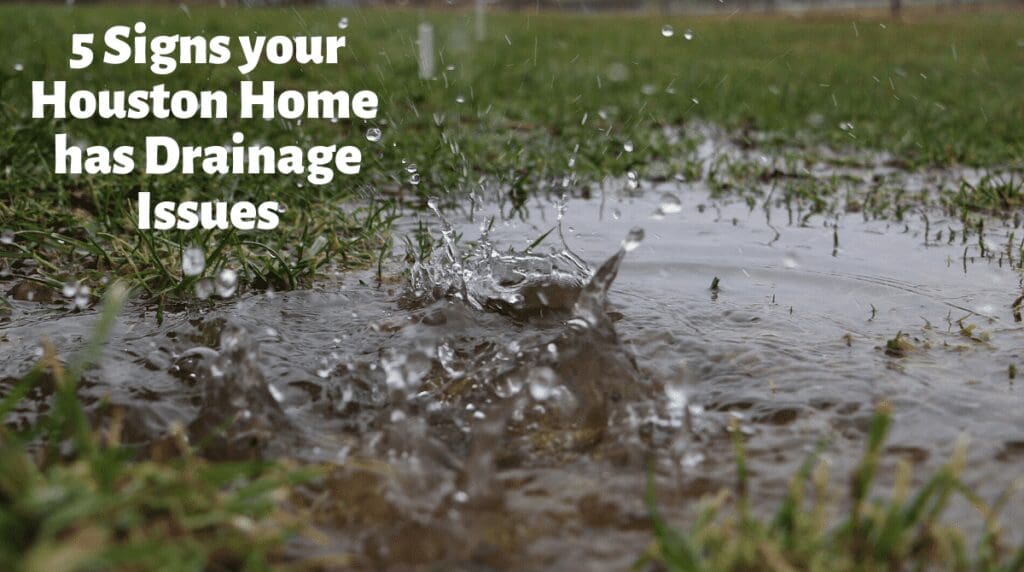Drainage issues may not seem like the end of the world, but the repercussions of foundation issues could eventually mean thousands and thousands of dollars in repair. Drainage issues, and the resulting excess of water, could lead to loss of foundation stability, as well as structural foundation damage. Drainage issues could also cause insect infestations, mold, and allergens, which would directly impact the health of those living within the house. Other possibilities for issues caused by poor drainage are termite infestations, and discoloration, and premature aging of concrete and exterior brick. These problems range from inconvenient to detrimental, so Allied has put together this guide on 5 signs that your home has drainage issues that need to be addressed.
Issues with Gutters and Downspouts
Gutters start to show issues, usually, when they are extremely clogged. Trees around homes can exacerbate gutter clogging by distributing dead leaves and debris directly into the gutters. These kinds of clogs are normally seen when there is an extremely large amount of water flowing over the gutters, usually in a ‘waterfall’ type of gushing. However, this isn’t the only sign that gutters are clogged. Dirt that leaves vertical lines on the outside of gutters, mud that spatters on sidings, and paint peeling in vertical strips are other signs that gutters are clogged up. Clogged gutters not only could result in the gutter becoming too heavy and falling, potentially causing damage to the house or people who live within it, but clogged gutters can result in rotting siding, ruined paint jobs, or even structural damage.
Downspouts are integral to directing water away from a home – but if done incorrectly, it can result in more damage than good. One inch of rain across 1,000 square feet of roof results in enough runoff to fill a bathtub more than 10 times. If that much water is dumped too close to the home, it will seep into the soil and weaken the integrity of the soil that holds up the foundation. This could result in severe foundation damage! Having to repair a foundation is far more expensive than redirecting a downspout into a better location.
Foundational Erosion and Cracking Sheetrock
It is important to keep an eye on foundational erosion. The easiest way to do this is to watch the foundational slab after a rainstorm. By taking note of how high the soil is before the storm, and then taking note of the soil level after, it can allow for the determination of whether or not the soil is being washed away. Also keep note of how long the water remained, as it could indicate that the yard itself is not properly draining – more on that later.
Cracking sheetrock may seem like a normal indication of foundational settling, and in some cases it is! However, it is not the only possibility. With the soil being washed away by rain, it can often cause shifting of the foundation that can result in interior damages, as well as needing an entire foundation repair.
Mildew in the Attic
The attic may not be the first place that most would look for drainage issues, but it is a common problem! Oftentimes, mildew in the attic ties with gutter or downspout issues. Having water held around the roof can result in this mildew building up in the attic, so if it is noticed, it is important to look for other potential signs of further issues.
Bowing Floors
Bowing floors is a sign that drainage may have occurred – but also a sign that the home as a whole has shifted. Not only is this a drainage problem, but it is a foundational problem that will need to be addressed at the same time as the drainage problem. Bowed floors present in a variety of different ways, but the most common signs of bowing floors start with boards or tiles that begin to pop up out of place. Often, when these problems begin to present themselves, doors will also begin to have issues closing. This is a very common sign of foundational problems.
Puddles in the Yard
Puddles can be fun to play in for a little while, but puddles that stay and do not go away are a sign of a serious drainage problem. Yards need to be built in a specific way to allow for drainage, whether that is the yard itself draining to a drainage ditch, or the yard sloping to a street that will carry the water away from the home. If there are multiple puddles at all times, and they are near the house, they can put the foundation at risk.
Another puddle to look out for is a puddle in your crawl space. Crawl spaces, contrary to popular belief, are not meant to be dank, moist places. Crawl spaces should remain dry year-round. If they are not, not only is this a sign of drainage issues, but the water in the crawl space can damage beams, allowing them to rot. This can put the safety of the home in serious jeopardy. It can also cause mold and lower the air quality of the home – not a good sign!
With the multitude of problems that drainage issues can cause, it is important that they be addressed before they can cause any more potential damage. With drainage issues potentially leading to life-threatening conditions like mold or foundational problems, be sure to address drainage issues as soon as they are noticed. For more peace of mind, reach out to Allied for a free estimate that can determine the health of your foundation and alert you to any issues that need to be addressed further.

